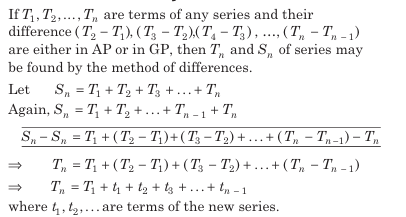Sequence
\(\bullet\) By a Sequence we mean a list of numbers, arranged according to some definite rule.
or
We definite a sequence as a function whose domain is the set of natural numbers or some subsets of type \(\{1,\ 2,\ 3,\ ....\ k\}.\)
\(\bullet\) If \(a_1,\ a_2,\ a_3,\ ...\ a_n, ....\) is a sequence, then the expression \(a_1+\ a_2+\ a_3 +\ ...\ a_n +....\) is called the series.
\(\bullet\) If the terms of a sequence follow a certain pattern, then it is called a progression.


Arithmetic Progression (AP)
Arithmetic Progression (AP)
\(\bullet\) It is a sequence in which the difference between any two consecutive terms is always same
\(\bullet\) An AP can be represented as \(a,\ a + d,\ a + 2d,\ a + 3d, ...\) where, \(a\) is the first term, \(d\) is the common difference.
\(\bullet\) The \(n^{th}\) term, \(t_n= a \ +\ (n-1)d\)
\(\bullet\) Common difference \(d=t_n-t_{n-1}\)
\(\bullet\) The \(n^{th}\) term from end, \(t=l\ -\ (n-1)d,\) where \(l\) is the last term.
\(\bullet\) Sum of first \(n\) terms, \(S_n=\frac{n}{2}\ [2a\ +\ (n-1)d]\ =\ \frac{n}{2}\ [a\ +\ l],\) where \(l\) is the last term.
\(\bullet\) If sum of \(n\) terms is \(S_n, \) then \(n^{th}\) term is \(t_n=S_n\ -\ S_{n-1},\ t_n = \frac{1}{2}\ [t_{n-k}\ +\ t_{n\ +\ k}],\) where \(k \lt n\)


Arithmetic Mean(AM)
ARITHMETIC MEAN (AM)
\(\bullet\) If \(a,\ A\ and\ B\) are in AP, then \(A=\frac{a+b}{2}\) is the arithmetic mean of \(a\ and \ b\)
\(\bullet\) If \(a,\ A_1,\ A_2, ..., A_n,\ b\) are in AP, then \(A_1,\ A_2, ..., A_n\) are the \(n\) arithmetic means between \(a\ and\ b\).
\(\bullet\) The \(n\) arithmetic means \(A_1,\ A_2, ..., A_n\), between \(a\ and \ b\) are given by the formula \(A_r= a\ +\ \frac{r\ (b-a)}{n+1}\ \forall\ r=1,2,...n\)
\(\bullet\) Sum of \(n\ \text{AM's}\) inserted between \(a\ and\ b\) is \(n\ \text{A}\) i.e.
\(A_1\ +\ A_2\ +\ A_3\ +...\ +\ A_n=n\ \big(\frac{a+b}{2}\big)\)
\(\underline{\overline{NOTE}}\ \ \ \bullet\) The AM of \(n\) numbers \(a_1, a_2, ..., a_n\) is given by
\(AM=\frac{(a_1\ +\ a_2\ +\ a_3\ +...\ +\ a_n)}{n}\)


Geometric Progression (GP)
A geometric progression (GP) is a sequence of numbers, whose first term is non-zero and each of the terms is obtained by multiplying its just preceding term by a constant quantity. This constant quantity is called the common ratio of the GP
In other words, if \(a_1, a_2, a_3, \ldots, a_n\) are in GP, then
\(
\frac{a_2}{a_1}=\frac{a_3}{a_2}=\ldots=\frac{a_n}{a_{n-1}}=r
\)
r is known as common ratio of GP.
If a is the first term and r is the common ratio, then GP can be written as \(a, a r, a r^2, \ldots\), \(a r^{n-1} .(a \neq 0)\) e.g. 2,4,8,16, \(\ldots\)


The Nth Term Of A GP (General Term)
Let \( a\) be the first term, \( r\) be the common ratio and \(l\) be the last term of a GP, then \( n\)th term is given by
\( T_n=l=a r^{n-1}, \text { where } r=\frac{T_n}{T_{n-1}} \)
The \(nth\) term from last is, \(T_n{ }^{\prime}=\frac{l}{r^{n-1}}\)


Geometric Mean
Geometric Mean
If we insert one geometric mean between two numbers $a$ and $b$, then
\( \text { Geometric mean }=\sqrt{a b} \text {. } \)
Important Points
- The product of n geometric means between a and b is equal to the nth power of geometric mean of a and b i.e.,
\(
G_1 \cdot G_2 \cdots \cdot G_n=(a b)^{n / 2}=G^n
\)
- The product of n geometric means between a and \(\frac{1}{a}\) is 1 .
- The geometric mean of n positive numbers \(a_1, a_2, a_3, \ldots, a_n\) is \(\mathrm{GM}=\left(a_1 a_2 a_3 \ldots a_n\right)^{1 / n}\).
- If A and G be the AM and GM between two positive numbers, then the numbers are \(A \pm \sqrt{A^2-G^2}\)
- If A and G are respectively AM and GM between two positive numbers $a$ and b, then the quadratic equation having a, b as its roots is
\(
x^2-2 A x+G^2=0
\)


Relation Among Arithmetic Mean And Geometric Mean
Let a and b be two real positive and unequal numbers and A, G, H are arithmetic, geometric and harmonic mean respectively between them.
Then,
\(
A=\frac{a+b}{2}, G=\sqrt{a b}
\)
Now,
\(
\begin{aligned}
A-G & =\frac{a+b}{2}-\sqrt{a b} \\
& =\frac{a+b-2 \sqrt{a b}}{2}=\left(\frac{\sqrt{a}-\sqrt{b}}{\sqrt{2}}\right)^2>0
\end{aligned}
\)
\(
\begin{array}{lrr}
\therefore & A-G>0 & {[\because a \text { and } b \text { are posi } 1} \\
\Rightarrow & A>G &
\end{array}
\)


Nth Term Of AP
The nth term of an AP
Let \(a\) be the first term \(d\) be the common difference and \(l\) be the last term of an AP, then \(n\) th term is given by
\( T_n=l=a+(n-1) d, \text { where } d=T_n-T_{n-1} \)
The \(nth \)term from last is \(T_n=l-(n-1) d\)
The sum of \(\boldsymbol{n}\) terms of an AP
Suppose there are\( n\) terms of a sequence, whose first term is \(a\), common difference is d and last term is \(l\), then sum of \(n\) terms is given by
\(
S_n=\frac{n}{2}[2 a+(n-1) d]=\frac{n}{2}[a+l]
\)


The Sum Of N terms Of A GP
Suppose there are n terms of a sequence, whose first term is a, common ratio is r and last term is \(l\), then sum of n terms is given by
\(
S_n=\left\{\begin{array}{cc}
\frac{\alpha\left(r^n-1\right)}{r-1}, & \text { when } r>1 \\
\frac{a\left(1-r^n\right)}{1-r}, & \text { when } r<1 \\
\text { na } & \text { when } r=1
\end{array}\right.
\)
If, terms are infinite, then sum of GP is,
\(
S_{\infty}=\frac{a}{1-r}, \text { when }|r|<1
\)
Note
- If \(a, b, c, d \ldots\) are in GP, they are also in continued proportion i.e.
\(
\frac{a}{b}=\frac{b}{c}=\frac{c}{d}=\ldots=\frac{1}{r}
\)
- If first term of a GP of n terms is a and last term is \(l\). Then, the product of all the terms of the GP is \((a /)^{n / 2}\).
- If \(a, b, c\) are in AP, as well as in GP, then \(a=b=c\).


Sequence
A set of numbers arranged in a definite order according to some definite rule is called a sequence.
Series
If \(a_1, a_2, \ldots, a_n\)is a sequence, then the expression \(a_1+a_2+\ldots+a_n+\ldots\) is called the series. The series is said to be finite or infinite according as the given series is finite or infinite.
e.g. (i) \(2+4+6+8+\ldots+20\) is a finite series.
(ii) \( 1+3+5+\ldots\) is an infinite series.
Progression
It is not necessary that the terms of a sequence always follow a certain pattern or they are described by some explicity formula for the $n$th term. Those sequences whose terms follow certain patterns are called progression.
OR
If the terms of a sequence are written under specific conditions, then the sequence is called progression.


ArithmeticProgression(AP)
A sequence is said to be an arithmetic progression, if the difference of a term and its previous term is always same. i.e.
\(
a_{n+1}-a_n=\text { Constant }(=d), \forall n \in N
\)
The constant difference, generally denoted by \(d\), is called the common difference.
OR
An arithmetic progression (AP) is a sequence whose terms increase or decrease by a fixed number. This fixed number is called the common difference of the AP.
In other words, if \(a_1, a_2, a_3, \ldots, a_n\) are in AP, then
\(
a_2-a_1=a_3-a_2=\ldots=a_n-a_{n-1}=d
\)
If $a$ is the first term and \(d\)is the common difference, then AP can be written as \(a, a+d, a+2 d, \ldots,\{a+(n-1) d\}\)
e.g.
(i) \(1,3,5,7, \ldots\)
(ii) \(2,4,6, \ldots\)


 beeTokens
beeTokens 



